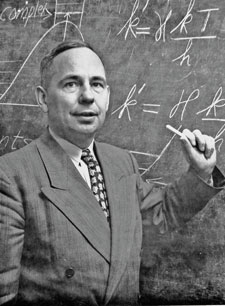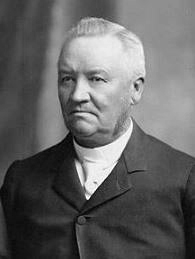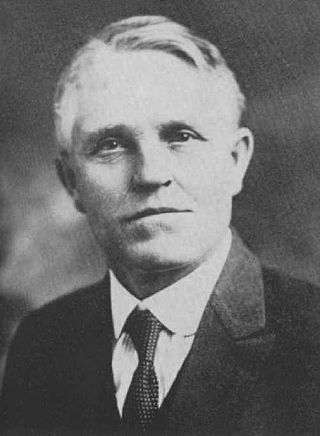
Henry Eyring was a Mexico-born United States theoretical chemist whose primary contribution was in the study of chemical reaction rates and intermediates. Eyring developed the Absolute Rate Theory or Transition state theory of chemical reactions, connecting the fields of chemistry and physics through atomic theory, quantum theory, and statistical mechanics.

Marion George Romney was an apostle and a member of the First Presidency of the Church of Jesus Christ of Latter-day Saints.

Anthony Woodward Ivins was an apostle of the Church of Jesus Christ of Latter-day Saints and was a member of the church's First Presidency from 1921 until his death.

Rey Lucero Pratt served the Church of Jesus Christ of Latter-day Saints for 23 years as president of its Mexican Mission and for six years as a general authority. Pratt helped establish the church in Mexico and among Spanish-speaking populations in the United States and Argentina. He also translated LDS Church materials into Spanish, wrote magazine articles, and spoke regularly at general conference.

Colonia Juárez is a small town in the northern part of the Mexican state of Chihuahua. Colonia Juárez is located in the valley of the Piedras Verdes River on the western edge of the Chihuahuan Desert and beneath the eastern front of the Sierra Madre Occidental. It is roughly 9 miles (14 km) north of Mata Ortiz and 12 miles (19 km) southwest of Nuevo Casas Grandes. The town had a population of 1,035 in 2010.

Anthon Henrik Lund was a member of the Quorum of the Twelve Apostles and the First Presidency of the Church of Jesus Christ of Latter-day Saints and a prominent Utah leader.

The Romney family is prominent in U.S. politics. Its family members include George W. Romney (1907–1995), the 43rd Governor of Michigan (1963–1969), and his son, Mitt Romney, who was the 70th Governor of Massachusetts (2003–2007), the 2012 Republican U.S. Presidential nominee, and is currently a U.S. Senator for Utah. George W. Romney's father was Gaskell Romney (1871–1955), and his mother was Anna Amelia Pratt (1876–1926). Anna's grandfather was the renowned early Latter-day Saint apostle Parley Parker Pratt.

The Mormon colonies in Mexico are settlements located near the Sierra Madre mountains in northern Mexico which were established by members of the Church of Jesus Christ of Latter-day Saints beginning in 1885. The colonists came to Mexico due to federal attempts to curb and prosecute polygamy in the United States. Plural marriage, as polygamous relationships were called by church members, was an important tenet of the church—although it was never practiced by a majority of the membership.

Colonia Dublán began as a Mormon colony, located in the state of Chihuahua, Mexico. It is now a part of Nuevo Casas Grandes Municipality. It is one of two surviving Mormon colonies in Mexico.

Antoine Ridgeway Ivins was a member of the First Council of the Seventy of the Church of Jesus Christ of Latter-day Saints from 1931 until his death.

Miles Park Romney was a prominent American builder in the Church of Jesus Christ of Latter-day Saints. He was born in Nauvoo, Illinois, the son of Miles Romney. He was the president of the St. George Social Hall Company and the St. George Dramatic Association, and also served as a chief of police, attorney-at-law, newspaper editor, and architect. One of his sons, Gaskell Romney, was the father of George W. Romney and grandfather of Mitt Romney.

Gaskell Romney is regarded as a patriarch of the Romney family, a U.S. political family. Romney was born in St. George, in what was then the Utah Territory, the son of Miles Park Romney and Hannah Hood Hill.

Lorin Farr was a Mormon pioneer and the first mayor of Ogden, Utah.

The Church of Jesus Christ of Latter-day Saints has had a presence in Mexico since 1874. Mexico has the largest body of LDS Church members outside of the United States. Membership grew nearly 15% between 2011 and 2021. In the 2010 Mexican census, 314,932 individuals self-identified most closely to the LDS Church.

The Pratt family is made up of the descendants of the Mormon pioneer brothers, Parley Parker Pratt and his brother Orson Pratt, whose father was Jared Pratt (1769–1839). It has many members in Utah, and other parts of the U.S. There are many branches of the Pratt family, such as the Romney family and the Huntsman family.
Prattville was a location in Sevier County, Utah, United States, settled under the leadership of Helaman Pratt in 1873. Pratt served as the first branch president at this location. The settlement was largely abandoned in 1878, and the LDS branch was dissolved that year.

Henry Carlos Ferdinand Eyring was a prominent mid-level leader of the Church of Jesus Christ of Latter-day Saints in the United States and Mexico during the 19th and early-20th centuries. He was also mayor of St. George, Utah. Eyring was the grandfather of chemist Henry Eyring and Camilla Eyring Kimball, wife of LDS Church president Spencer W. Kimball.

Carl Heinrich "Charles Henry" Wilcken was a German-American artilleryman who was awarded the Iron Cross by the King of Prussia, Frederick William IV.

Colonia Díaz was the first permanent Mormon colony in Mexico, located along the Casas Grandes River in the northwest of the state of Chihuahua, Mexico. It is now a ghost town bordered on the east by the Sierra Madre Occidental. It was the nearest colony to the Mexico–United States border. By 1900, Díaz had grown to 623 inhabitants. In 1912, during the Mexican revolution, Colonia Díaz was intentionally burned and destroyed. Other neighboring colonies were established after Colonia Díaz in the late 19th century, of which only Colonia Dublán, sixty miles south of Colonia Díaz, and Colonia Juárez, 18 miles southeast of Colonia Dublán, are still inhabited.




















